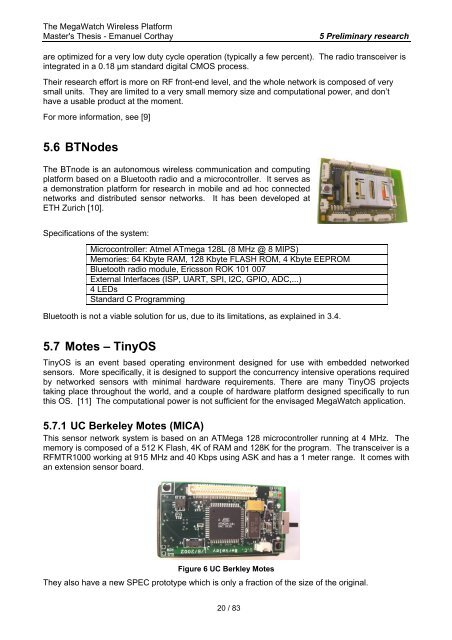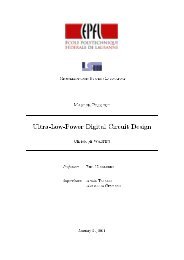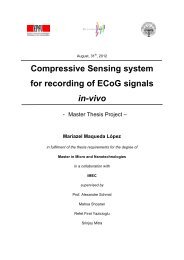Design and Realization of a Prototype Hardware Platform for ...
Design and Realization of a Prototype Hardware Platform for ...
Design and Realization of a Prototype Hardware Platform for ...
You also want an ePaper? Increase the reach of your titles
YUMPU automatically turns print PDFs into web optimized ePapers that Google loves.
The MegaWatch Wireless <strong>Plat<strong>for</strong>m</strong>Master's Thesis - Emanuel Corthay5 Preliminary researchare optimized <strong>for</strong> a very low duty cycle operation (typically a few percent). The radio transceiver isintegrated in a 0.18 µm st<strong>and</strong>ard digital CMOS process.Their research ef<strong>for</strong>t is more on RF front-end level, <strong>and</strong> the whole network is composed <strong>of</strong> verysmall units. They are limited to a very small memory size <strong>and</strong> computational power, <strong>and</strong> don’thave a usable product at the moment.For more in<strong>for</strong>mation, see [9]5.6 BTNodesThe BTnode is an autonomous wireless communication <strong>and</strong> computingplat<strong>for</strong>m based on a Bluetooth radio <strong>and</strong> a microcontroller. It serves asa demonstration plat<strong>for</strong>m <strong>for</strong> research in mobile <strong>and</strong> ad hoc connectednetworks <strong>and</strong> distributed sensor networks. It has been developed atETH Zurich [10].Specifications <strong>of</strong> the system:Microcontroller: Atmel ATmega 128L (8 MHz @ 8 MIPS)Memories: 64 Kbyte RAM, 128 Kbyte FLASH ROM, 4 Kbyte EEPROMBluetooth radio module, Ericsson ROK 101 007External Interfaces (ISP, UART, SPI, I2C, GPIO, ADC,...)4 LEDsSt<strong>and</strong>ard C ProgrammingBluetooth is not a viable solution <strong>for</strong> us, due to its limitations, as explained in 3.4.5.7 Motes – TinyOSTinyOS is an event based operating environment designed <strong>for</strong> use with embedded networkedsensors. More specifically, it is designed to support the concurrency intensive operations requiredby networked sensors with minimal hardware requirements. There are many TinyOS projectstaking place throughout the world, <strong>and</strong> a couple <strong>of</strong> hardware plat<strong>for</strong>m designed specifically to runthis OS. [11] The computational power is not sufficient <strong>for</strong> the envisaged MegaWatch application.5.7.1 UC Berkeley Motes (MICA)This sensor network system is based on an ATMega 128 microcontroller running at 4 MHz. Thememory is composed <strong>of</strong> a 512 K Flash, 4K <strong>of</strong> RAM <strong>and</strong> 128K <strong>for</strong> the program. The transceiver is aRFMTR1000 working at 915 MHz <strong>and</strong> 40 Kbps using ASK <strong>and</strong> has a 1 meter range. It comes withan extension sensor board.Figure 6 UC Berkley MotesThey also have a new SPEC prototype which is only a fraction <strong>of</strong> the size <strong>of</strong> the original.20 / 83















